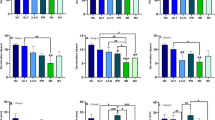Abstract
Phytotoxicity assessments were performed to compare responses of Typha latifolia (L.) seeds to atrazine (only) and atrazine + S-metolachlor exposure concentrations of 0.03, 0.3, 3, and 30 mg L−1, as well as permethrin exposure concentrations of 0.008, 0.08, 0.8, and 8 mg L−1. All atrazine + S-metolachlor exposures resulted in significantly reduced radicle development (p < 0.001). A stimulatory effect for coleoptile development was noted in the three highest atrazine (only) exposures (p = 0.0030, 0.0181, and 0.0016, respectively). This research provides data concerning the relative sensitivity of T. latifolia seeds to pesticides commonly encountered in agricultural settings, as well as critical understanding and development of using T. latifolia in phytoremediation efforts for pesticide exposures.
Similar content being viewed by others
References
Amaya-Chávez A, Martínez-Tabche L, López-López E, Galar-Martínez M (2006) Methyl parathion toxicity to and removal efficiency by Typha latifolia in water and artificial sediments. Chemosphere 63:1124–1129
Battaglin WA, Furlong ET, Burkhardt MR, Peter CJ (2000) Occurrence of sulfonylurea, sulfonamide, imidazolinone, and other herbicides in rivers, reservoirs and ground water in the Midwestern United States, 1998. Sci Total Environ 248:123–133
Burhan N, Shaukat SS (2000) Effects of atrazine and phenolic compounds on germination and seedling growth of some crop plants. Pak J Biol Sci 3(2):369–374
Dubbe DR, Garver EG, Pratt DC (1988) Production of cattail (Typha spp.) biomass in Minnesota, USA. Biomass 17(2):79–104
Esser HO, Dupuis G, Ebert E, Vogel C, Marco GJ (1988) s-Triazines. In: Kearney PC, Kaufman DD (eds) Herbicides: chemistry, degredation, and mode of action. Dekker, New York
García-Lledó A, Ruiz-Rueda O, Vilar-Sanz A, Sala L, Bañeras L (2011) Nitrogen removal efficiencies in a free water surface constructed wetland in relation to plant coverage. Ecol Eng 37:678–684
Gianessi L, Reigner N (2006a) Pesticide use in U.S. crop production: 2002 with comparison to 1992 and 1997, fungicides and herbicides. CropLife Foundation, Washington, DC
Gianessi L, Reigner N (2006b) Pesticide use in U.S. crop production: 2002, insecticides and other pesticides. CropLife Foundation, Washington, DC
Liu TF, Wang T, Sun C, Wang YM (2009) Single and joint toxicity of cypermethrin and copper on Chinese cabbage (Pakchoi) seeds. J Hazard Mater 163:344–348
Moore MT, Huggett DB, Huddleston GM III, Rodgers JH Jr, Cooper CM (1999) Herbicide effects on Typha latifolia (Linneaus) germination and root and shoot development. Chemosphere 38(15):3637–3647
Murphy EVA (1959) Indian uses of native plants. Mendocino County Historical Society, p 81
Peterson HG, Boutin C, Martin PA, Freemark KE, Ruecker NJ, Moody NJ (1994) Aquatic phyto-toxicity of 23 pesticides applied at expected environmental concentrations. Aquat Toxicol 28:275–292
Rivard PG, Woodard PM (1989) Light, ash, and pH effects on the germination and seedling growth of Typha latifolia (cattail). Can J Bot 67:1330–1336
Shardendu N, Salhani N, Boulyga SF, Stengel E (2003) Phytoremediation of selenium by two helophyte species in subsurface flow constructed wetland. Chemosphere 50:967–973
Triplett GB, Conner BJ, Edwards WM (1978) Transport of atrazine and simazine in runoff from conventional and no-tillage corn. J Environ Qual 7(1):77–84
Tu CM (1982) Effects of some pesticides on Rhizobium japonicum and on the seed germination and pathogens of soybean. Chemosphere 11(10):1027–1033
US EPA (2006) Reregistration eligibility decision (RED) for permethrin. EPA 738-R-06-017. Washington, DC
Wang W (1987) Root elongation method for toxicity testing of organic and inorganic pollutants. Environ Toxicol Chem 6:409–414
Wang W, Williams JM (1988) Screening and biomonitoring of industrial effluents using phytotoxicity tests. Environ Toxicol Chem 7:645–652
Wang W, Williams JM (1990) The use of phytotoxicity tests (common duckweed, cabbage, and millet) for determining effluent toxicity. Environ Monit Assess 14:45–58
Wilson PC, Whitwell T, Klaine SJ (2000) Metalaxyl and simazine toxicity to and uptake by Typha latifolia. Arch Environ Contam Toxicol 39:282–288
Acknowledgments
Thanks to Renee Russell for pesticide analyses. Mention of trade names or commercial products in this article is solely for the purpose of providing specific information and does not imply recommendation or endorsement by the US Department of Agriculture (USDA). The USDA is an equal opportunity employer and provider.
Author information
Authors and Affiliations
Corresponding author
Rights and permissions
About this article
Cite this article
Moore, M.T., Locke, M.A. Phytotoxicity of Atrazine, S-Metolachlor, and Permethrin to Typha latifolia (Linneaus) Germination and Seedling Growth. Bull Environ Contam Toxicol 89, 292–295 (2012). https://doi.org/10.1007/s00128-012-0682-z
Received:
Accepted:
Published:
Issue Date:
DOI: https://doi.org/10.1007/s00128-012-0682-z




